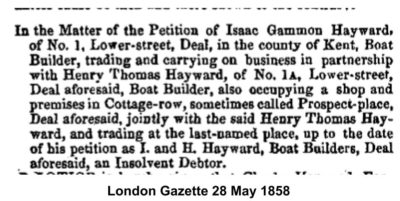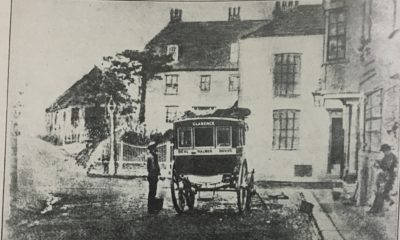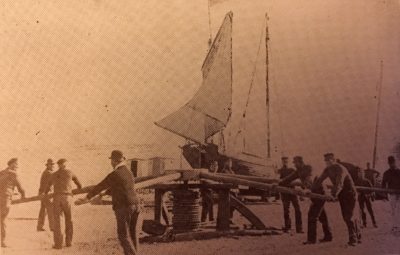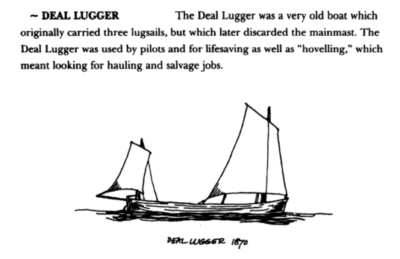Isaac Gammon Hayward
Prospect House, Lower Street
Cottage Row
2 Albert Place
5 Victoria Cottages, Middle Deal Road
Occupation: Boatbuilder
Isaac followed his father, Thomas Hayward, into the boatbuilding trade first working for his father then, after his death, he and his brother, Henry Thomas, became partners and carried on their business from the same shop and yard, in Cottage Row now Wellington Road, that had once been their father’s.
The Boatyard and shop can be seen just behind and to the left of Prospect House.
The adjoining Prospect Cottage is obscured by the property to the right of the fenced front garden.
This front garden was later sold and two properties built on it.
Bankruptcy
 By the late 1850s, Isaac and Henry’s business wasn’t doing so well and the brothers filed for bankruptcy. The home addresses given for them at the time were 1 and 1a Lower Street these are Prospect House, where Isaac and his family lived and the smaller adjoining property Prospect Cottage.
By the late 1850s, Isaac and Henry’s business wasn’t doing so well and the brothers filed for bankruptcy. The home addresses given for them at the time were 1 and 1a Lower Street these are Prospect House, where Isaac and his family lived and the smaller adjoining property Prospect Cottage.
After this Isaac starts to rebuild the business on his own and it was at this time that he sold Prospect House. Whether he had to sell the boatbuilder’s shop and yard we don’t for certain but the Pavement Commission, when discussing Cottage Row on the 28 March 1865, said that as “….the shop and yard were on the market it would probably be advisable to purchase a strip the length of the yard for the purpose of widening the road…”. The newspapers do tell us though that his boats
after that date were still being launched from the ‘South-end’ so where
he actually then carried on his business is not known.
After the sale of Prospect House, Isaac and his family moved to Albert Place, which now is where Mill Road meets London Road. The houses there were demolished to make way for the extension railway line to Dover which opened in 1881. So Isaac, his wife Eliza and their spinster daughter, Sarah Ann, had to move again this time to Victoria Cottages, on Middle Deal Road. Also with them is their seven-year-old granddaughter Elizabeth, the daughter of their son, another Henry Thomas.
On 12 July 1871 Isaac again files for bankruptcy but as there is only the first notice given in the Gazette and as the completion and launch of the Galatea coincided with this Isaac’s financial difficulties may have been resolved. None the less it shows how precarious the boatbuilding and indeed being in any business was at this time.
Isaac Hayward’s Luggers
 The launch of the luggers built by Isaac was often a cause for celebration and reported on in the newspapers. In 1867 there was ‘The Garland’ and the following year there was ‘The Mary. All of the vessels built by the Haywards were usually hauled up South Street on greased wood by men pulling on ropes and usually for the price of a pint or two. The Alexandra though, built by the Haywards’ in 1866, and the largest boat ever to be built in Deal, had to be hauled up South Street to the beach by a capstan at the top. Isaac’s son, another Thomas Hayward, described in the book ‘The Last of the Luggers’ how the boatbuilder’s shop had to be lengthened and the floor dug out to accommodate its building. Sadly, in 1870 the Alexandra, while trying to unload the cargo of another vessel that had run aground on the Goodwins, struck a piece of an old wreck and rapidly sunk. Her crew luckily survived.
The launch of the luggers built by Isaac was often a cause for celebration and reported on in the newspapers. In 1867 there was ‘The Garland’ and the following year there was ‘The Mary. All of the vessels built by the Haywards were usually hauled up South Street on greased wood by men pulling on ropes and usually for the price of a pint or two. The Alexandra though, built by the Haywards’ in 1866, and the largest boat ever to be built in Deal, had to be hauled up South Street to the beach by a capstan at the top. Isaac’s son, another Thomas Hayward, described in the book ‘The Last of the Luggers’ how the boatbuilder’s shop had to be lengthened and the floor dug out to accommodate its building. Sadly, in 1870 the Alexandra, while trying to unload the cargo of another vessel that had run aground on the Goodwins, struck a piece of an old wreck and rapidly sunk. Her crew luckily survived.
Over the years many of the vessels that the Haywards built took part in the annual Regatta and in 1883 Isaac officiated as the starter to the boat races. The results of which were printed in the newspapers giving the names of the vessels and their crews.
Death and Burial
Issac died in 1887 aged 80 at 67a Middle Street. This is the address from where he was buried from so he may have moved again. Eliza died in 1896 and was buried from 92 Middle Street, which at the time was the Prince Albert public house. Why she is here we don’t know as on the 1891 census Eliza was living in Granville Street, Walmer and taking in laundry with Sarah Ann to make ends meet, Elizabeth, her granddaughter, is still with them then. Sarah Ann sadly ended her life in Eastry Union Infirmary and was buried in St. Leonard’s in May 1916. As for Elizabeth, it looks as if she moved to Walthamstow in Essex and married there in 1897.
Three of Isaac’s sons carried on the family tradition of boatbuilding. Henry Thomas becomes a boatbuilder in Deal, John Gammon a shipwright in Gillingham, William Gammon a boatbuilder in Prittlewell Essex. Thomas became a teacher in Berkshire and Issac Gammon jnr. became a watchmaker and eventually the Keeper of the Timeball Tower where he lived with his wife and nine children before he died there in 1904 aged just 52.


